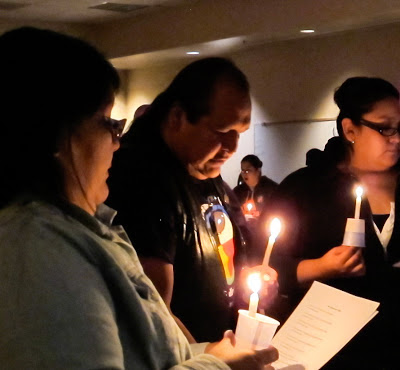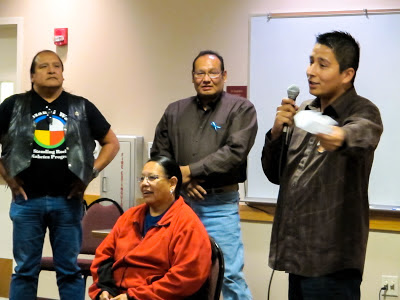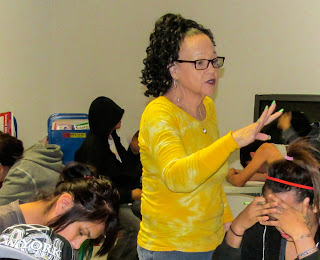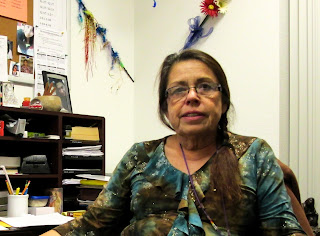Tribes take on youth suicide with skits, mustangs and ceremonies
This article appeared in Indian Country Today in 2013. For more on topics like this, see my book, American Apartheid: The Native American Struggle....
On the Pine Ridge Indian Reservation, youngsters perform skits aimed at
lowering their tribe’s youth-suicide rate. Playing with mustangs helps prevent self-harm
among the children of the Gila River Indian Community. On the Standing Rock
Sioux Reservation, tribal members who’ve lost family to suicide heal by
grieving together. In each of these three communities, youngsters kill themselves at a rate
at least triple the United States average.
 “American Indian and Alaska Native
youth have the highest suicide rates in the country,” said Richard
McKeon, chief of Substance Abuse and Mental Health Services Administration’s suicide-prevention
branch. To help quell this epidemic, Native groups received about a third of
the agency’s recent round of grants. “We want to help as many as tribes as
possible reduce risk factors, such as substance abuse and depression.”
“American Indian and Alaska Native
youth have the highest suicide rates in the country,” said Richard
McKeon, chief of Substance Abuse and Mental Health Services Administration’s suicide-prevention
branch. To help quell this epidemic, Native groups received about a third of
the agency’s recent round of grants. “We want to help as many as tribes as
possible reduce risk factors, such as substance abuse and depression.”
With the grants, the tribes will
also bolster what scientists call protective factors. “For Native people, that
means connecting with culture, an extremely important asset, as well as family
and community,” said McKeon.
Throughout Indian Country, even very young children are included in
prevention events and activities. “On the Pine Ridge Indian
Reservation, we can start talking about suicide when kids are in pre-school,”
said Yvonne “Tiny” DeCory, staffer for the Sweetgrass Project, a tribal suicide
prevention program.
How do you broach such a subject with a five-year-old? “Our
kindergarteners can tell you about how daddy hung himself,” DeCory responded.
“They go to wakes and funerals. Suicide has become ‘normal’ to them.” So, she
and other mentors on Pine Ridge face the crisis square on, with frank words and
compassion.
DeCory’s description of the work at Pine Ridge could describe many
tribes’ efforts: “We have to end the silence and walk out of the darkness
together.” Here are ways tribes are helping their kids feel connected and valued.
Standing Rock Sioux Tribe: Healing
together
“Forever is a long, long time / So I will forever remember you.” The sweet
refrain floated over a November grieving ceremony on the Standing Rock Sioux
reservation. About 75 people had gathered for a meal and remembrance in a
meeting room of the tribe’s hotel in Mobridge, South Dakota. Youth suicide at
Standing Rock has been marked by not just high rates, but devastating clusters
of deaths. Seven youngsters in one tiny community killed themselves in six
weeks in 2009. Some clusters have been even higher, and others have been
included dozens of attempts, in addition to the deaths.
The singer at the gathering composed the plaint for relatives lost to
suicide—a son, a nephew, a niece, cousins and uncles, deaths stretching back to
the 1970s, she said. Veronica Iron Thunder, shown here at left in photo, who survived her own suicide
attempts, sang a traditional Lakota song intended to restore damaged spirits.
A third woman said she was finally able to accept her son’s death by
suicide—though she said, as do many survivors, that she still couldn’t
understand why it had happened. “After 15 years of mourning, I took flowers to
his grave and said, ‘goodbye, son.’”
“That was so important for others to hear,” said tribal wellness program
director Arleata Snell. Some Standing Rock families have been overwhelmed by
grief for years, unable to move on, she said. “Now, maybe they’ll see it is
possible to heal.”
In a slideshow, the beautiful, smiling faces of those lost to suicide
slipped across the screen. Almost all were in their teens and twenties. They
radiated hope. But they were also heartbreaking. A small indigenous community
had lost so many of those who should be leading it into the future.
“We’re in this together, from prevention to healing,” said Snell. “We’ve
trained youth how to recognize and report signs of suicide in their peers, and
adults know the suicide-prevention protocol ASIST. Schools, health service,
spiritual people—everyone here is helping stop youth suicide.”
These days, Standing Rock is experiencing an uneasy calm, with generally
lower numbers, said Snell. “If people are in crisis, they know who to call,
whether it’s our program or the national hotline—1-800-SAFE-TALK.” She also worked
with the national call center to route calls from Standing Rock to a local counselor.
Normally, Snell said, callers from across the nation get a professional
counselor who may be anywhere in the country. But now, Standing Rock callers
get a local person who understands how hard it is for people to get themselves
to help on big reservations, with their long distances, great poverty and
little access to transport.
Snell and her staff of four are the wellness program’s eyes and ears in
Standing Rock’s scattered communities. They respond immediately to suicide
ideations (plans) or attempts, contacting parents if minors are involved and
arranging transport to counseling or an emergency room.
 Ira Taken Alive, chair of the Standing Rock Sioux Suicide Task Force
called his tribe’s response to youth suicide “all hands on deck.” The task
force meets monthly. Members have discussed the little-understood fact that suicides
occur mostly in spring or fall. “It may be seasonal affective disorder and a
response to changing amounts of sunlight, though no one really knows,” said
Taken Alive.
Ira Taken Alive, chair of the Standing Rock Sioux Suicide Task Force
called his tribe’s response to youth suicide “all hands on deck.” The task
force meets monthly. Members have discussed the little-understood fact that suicides
occur mostly in spring or fall. “It may be seasonal affective disorder and a
response to changing amounts of sunlight, though no one really knows,” said
Taken Alive.
They’ve talked about substance abuse. “One thing is sure,” Taken Alive
said. “In 98 percent of attempts and completions here, alcohol or drugs were
involved. We need to get ahead of the substance-abuse issue, to be proactive,
not reactive.”
The grieving families ate together, then entertainer and motivational speaker
Mylo Redwater Smith, shown in photos above (at left) and below, closed the event. A 25-year-old Dakota from Crow Creek
Sioux Tribe, he lightened the atmosphere with jokes and skits. Then he launched into a
fast-moving analysis of how generations of attempts to assimilate tribal people
have meant loss upon loss—of homeland, language, cultural practices, the
ability to support their families, good health and more. As a result, Natives have taken up destructive behaviors—suicide, alcoholism,
domestic violence, drug use and other dysfunctions—and made them their “new
normal,” Smith said.
 “All the negative things add up for our children,” Smith said. “They say
to themselves, ‘I’m alone. It’s too hard.’ They may give up.” To help
youngsters overcome what he called the “reservation mentality,” they have to
connect with their culture, according to Smith. “Take them to the sweat. Teach
them to pray. In ceremony, I found who I was as a young Dakota man. That saved
my life.”
“All the negative things add up for our children,” Smith said. “They say
to themselves, ‘I’m alone. It’s too hard.’ They may give up.” To help
youngsters overcome what he called the “reservation mentality,” they have to
connect with their culture, according to Smith. “Take them to the sweat. Teach
them to pray. In ceremony, I found who I was as a young Dakota man. That saved
my life.”
Smith was optimistic. “It’s hard to be Indian,” he said. “But we as a
people are defining our problems and looking for solutions. This is a time of
healing.”
Gerald Iron Shield closed the day with a prayer and traditional Lakota
song. “We can become strong again,” he said.
Gila River Indian Community:
Mustang sallies
Herds of wild horses still roam free in the Gila River Indian
Community’s stretch of the Sonoran Desert, south of Phoenix, Arizona. Mustangs
are also important to a tribal youth suicide-prevention and life-skills program,
Kahv’Yoo (“horse”) Spirit, run by
horseman Andy Miritello, with therapist Shawn Rodrigues.
The kids don’t hop aboard wild animals and try to ride them, cautioned
Miritello. The program uses a ground-based method, EAGALA (Equine Assisted
Psychotherapy and Equine Assisted Learning), developed by the international
nonprofit of the same name. Everything happens on the ground, with kids on
foot, grooming and interacting with the animals, which include domesticated
horses. This eliminates the issues of power and control over the animal that
are essential to riding a horse, said Miritello.
Instead, people and animals are equals in a friendly, low-key herd
sharing a corral. This was apparent to Gila River youth, who used human imagery
to describe the horses. “They show emotions like people do,” said teen participant
Jacquelyn Osife.
Mustangs bring a special element to the mix. “They’re more alert and
sensitive than domesticated horses,” Miritello said. “They have to be to
survive. It’s literally in a mustang’s DNA. They also project a powerful sense
of life that inspires the children, who are from a horse culture.”
Some lessons involve observing the animals’ responses and figuring out
if they relate to other aspects of your life, said Julie Jimenez, prevention
administrator for the behavioral health department. “A child might observe,
‘that horse just walked away from me,’ then reveal that kids at school do the
same thing. The therapist might ask, ‘How did you approach the horse (or the
kids)?’ A conversation will develop from there.”
Handling a big animal is empowering, said Miritello. He described a girl
who became increasingly confident as she haltered a horse and led it around the
arena with a rope. For the next step, she removed the rope and circled the
corral, with the horse following freely, like an oversized friendly dog. “She
was thrilled,” he recalled.
The children’s achievements give them optimism and help them stay away
from life-threatening behaviors, including drugs, alcohol and self-harm,
according to Miritello. “They connect to self, peers, community and culture,”
he said. Teachers have reported better school attendance and behavior among
program participants.
All tribal youth aged 5 to 24 are eligible to participate in the
once-a-week, 8-week sessions, which can be repeated. Kahv’Yoo Spirit is among
several Gila River suicide-prevention initiatives supported by state funding
and the National Indian Health Board, said Jimenez. These include a summer
culture camp and a coalition of providers and community members who get the
prevention message out with block parties, a skateboarding competition and
other events. Meanwhile, 400 adults have learned a protocol for recognizing and
reporting signs of suicide.
Teen Kahv’Yoo Spirit participant Rodrigo Castellon said working with
horses was transforming. “You see the world with different, more positive
eyes.”
Oglala Sioux Tribe: Serious fun
 Night had fallen, and 32 teens living in Pine Ridge High School’s dorm,
in Pine Ridge, South Dakota, were seated around small tables in a common room.
Each group was quietly discussing things that could happen to a
person—learning a friend has been abused, coming home from school to find
auntie drunk, flunking a test, getting ketchup on a prom dress. They ranked
them from least to most serious.
Night had fallen, and 32 teens living in Pine Ridge High School’s dorm,
in Pine Ridge, South Dakota, were seated around small tables in a common room.
Each group was quietly discussing things that could happen to a
person—learning a friend has been abused, coming home from school to find
auntie drunk, flunking a test, getting ketchup on a prom dress. They ranked
them from least to most serious.
This was one of the problem-solving lessons the teens will complete
under the American Indian Life Skills Development curriculum, a
suicide-prevention syllabus for Native youth. Charismatic, high-energy Tiny DeCory, shown here, teaches the lessons through the
tribe’s Sweetgrass Project, run by Lisa Schrader-Dillon. The program just
received its second Garrett Lee Smith three-year grant. In the curriculum’s
original incarnation—as Zuni Life Skills Development—it eliminated youth
suicide at the pueblo for the 15 years it was in effect. It’s on SAMHSA’s list
of evidence-based (scientifically tested) practices.
As the Pine Ridge teens ranked each list, they announced their results.
Generally the groups agreed among each other, until four boys declared facial
blemishes to be life’s greatest disaster, to shrieks of laughter from the other
kids.
 “The issues are serious, but the way Tiny presents the material, the
students don’t think of it as a ‘curriculum’,” said dorm manager Allie Bad
Heart Bull, shown here. Bad Heart Bull radiates quiet capability and offers meditation and other
alternative healing practices to dorm residents.
“The issues are serious, but the way Tiny presents the material, the
students don’t think of it as a ‘curriculum’,” said dorm manager Allie Bad
Heart Bull, shown here. Bad Heart Bull radiates quiet capability and offers meditation and other
alternative healing practices to dorm residents.
“We’ve seen changes in behavior already,” said DeCory. “In the lessons,
the teens have talked about solutions to all kinds of problems. They’ve become
more communicative and seem stronger and happier.” Children on Pine Ridge have
the capacity for great resilience, she said. “We’re working to make this their
turnaround moment.”
The next day, DeCory’s youth theater group, B.E.A.R., performed for a
packed crowd at another reservation high school, shown here. B.E.A.R is also under the Sweetgrass
umbrella; the initials stand for Be Excited About Reading, while the name
refers to cultural beliefs about bears’ wisdom and strength. The group hands
out books and encourages literacy at its approximately four monthly shows on
and off the reservation.
 “We started out to improve test scores,” said DeCory. It soon became
apparent that B.E.A.R.’s youth audiences also wanted information about serious
issues they face. The group’s kid-developed skits don’t pull any punches. They
deal with teen pregnancy, coping with alcoholic relatives, suicide and other
problems youngsters in their audiences face. They provide information on where
to go for help.
“We started out to improve test scores,” said DeCory. It soon became
apparent that B.E.A.R.’s youth audiences also wanted information about serious
issues they face. The group’s kid-developed skits don’t pull any punches. They
deal with teen pregnancy, coping with alcoholic relatives, suicide and other
problems youngsters in their audiences face. They provide information on where
to go for help.
For its members, B.E.A.R. provides
the all-important, life-saving sense of connection. After Erin Miller’s mom saw
her perform, the two bonded powerfully. “We cried together,” said Erin, who’s
18. Shawn Keith, 23, has been with B.E.A.R. since he was a young
teen. “It means everything to me,” he said.
Text and photographs c. Stephanie Woodard, who wrote this story—part of a series on tribal efforts to prevent youth suicide—with support from the Fund for Investigative Journalism and the California Endowment Health Journalism Fellowship, a program of USC’s Annenberg School of Journalism.


